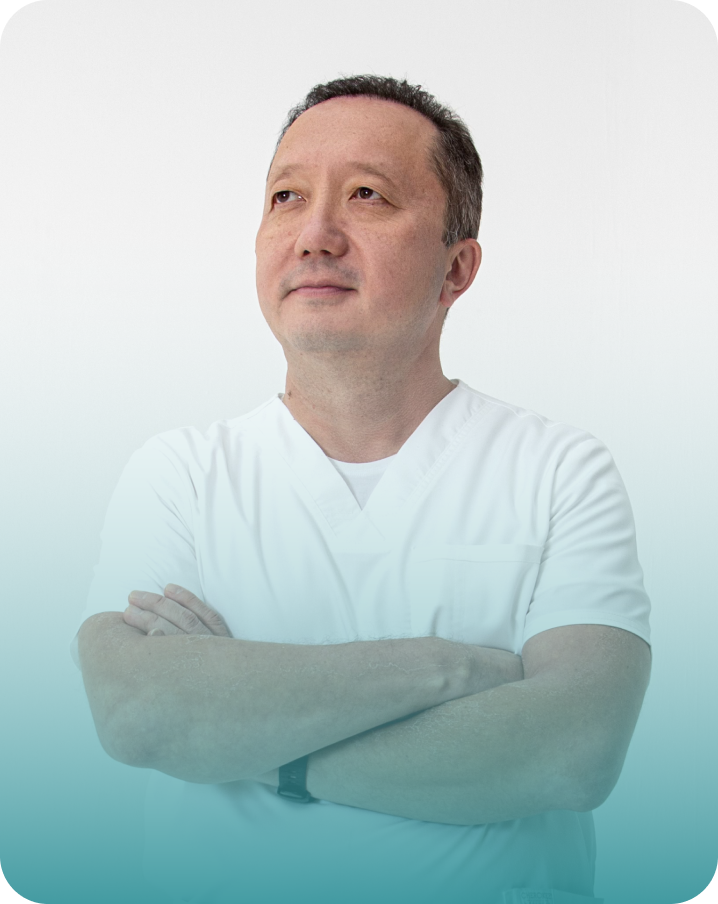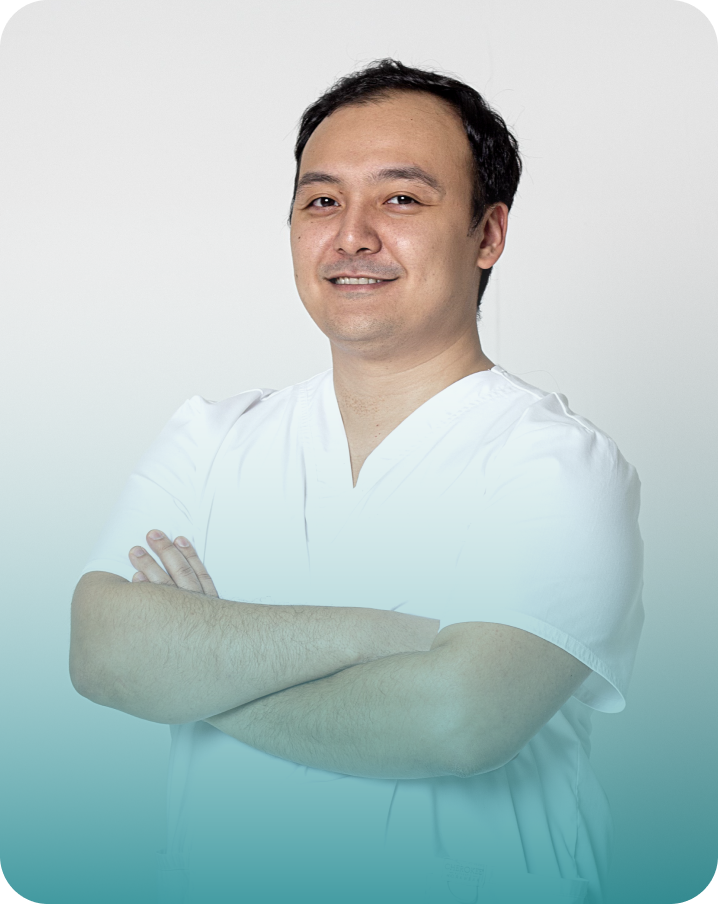



Our services




ABOUT US
The Clinic of Modern Neurology and Neurorehabilitation "Shashkin Clinic" provides high-quality and advanced medical care in the fields of neurology, neurosurgery, rehabilitation, psychiatry, speech therapy, and defectology.
Using proven treatment methods, our doctors are always ready to deliver the best treatment for your diagnosis, offering comprehensive and affordable diagnostic services. The clinic implements cutting-edge treatment technologies and conducts scientific research.
Using proven treatment methods, our doctors are always ready to deliver the best treatment for your diagnosis, offering comprehensive and affordable diagnostic services. The clinic implements cutting-edge treatment technologies and conducts scientific research.
Parkinson's Disease is a chronic progressive neurodegenerative disorder that affects the central nervous system, primarily impacting motor functions. Symptoms may include tremors, rigidity, and postural instability.
At our clinic, we provide comprehensive treatment. Initially, we review the patient's medical history, complaints, and main clinical symptoms to determine the primary algorithms for further examination. Next, we select the necessary treatment (complex neurosurgical operations, surgical procedures), followed by a rehabilitation course based on proven techniques for restoring lost functions and halting disease progression.
At our clinic, we provide comprehensive treatment. Initially, we review the patient's medical history, complaints, and main clinical symptoms to determine the primary algorithms for further examination. Next, we select the necessary treatment (complex neurosurgical operations, surgical procedures), followed by a rehabilitation course based on proven techniques for restoring lost functions and halting disease progression.
Epilepsy is a disorder characterized by sudden paroxysms caused by increased activity of neurons in the brain. These paroxysms are accompanied by spasms and convulsions, as well as loss of consciousness. As one of the most common neurological diseases worldwide, epilepsy can develop either as a side effect of another pathology or independently. One of the main symptoms of epilepsy is seizures, which have a cyclical nature and may include motor function disruptions, sensory organ failures, and emotional fluctuations.
Seizures can be single or serial, with primary signs including tongue biting, frothing at the mouth, cessation of breathing, convulsions, and gasping. The treatment process for epilepsy, regardless of the methods, takes a long time during which the patient must be under observation.
There are several treatment methods:
Seizures can be single or serial, with primary signs including tongue biting, frothing at the mouth, cessation of breathing, convulsions, and gasping. The treatment process for epilepsy, regardless of the methods, takes a long time during which the patient must be under observation.
There are several treatment methods:
- Medication Treatment. The main drugs used are anticonvulsants from different groups, which help stop seizures and prevent their recurrence. However, drug therapy aims to eliminate not only the seizures but also their underlying causes.
- Non-Medication Treatment. Many doctors recommend therapeutic exercises or yoga in addition to the main course of treatment.
- Surgical Treatment. Surgical intervention is rarely required and is performed when classical methods fail. Surgical treatment of epilepsy is divided into two types: removal of the brain area causing the seizures or implantation of a stimulator (for partial seizures), or the subpial transection method.
One of the most effective surgical treatments for Parkinson's disease is called deep brain stimulation (DBS). This method involves implanting electrodes into the brain, which then deliver electrical impulses to stimulate brain tissue, helping to overcome tremors, stiffness, and slow movements. This surgery is not intended for all patients with Parkinson's disease — it is performed on patients who meet specific criteria (link - patient selection for Deep Brain Stimulation).
The procedure is divided into two main stages:
1.Bilateral implantation of deep electrodes
2.Implantation of a permanent pulse generator and extension cables, followed by system connection
The procedure is divided into two main stages:
1.Bilateral implantation of deep electrodes
2.Implantation of a permanent pulse generator and extension cables, followed by system connection
Neurosurgical treatment for Parkinson's disease is performed when medication therapy does not yield the desired effect, and the symptoms lead to patient disability. Stereotactic surgery is a minimally invasive method of intervention in brain tissue. Depending on the type of intervention (destruction, stimulation, or biopsy), the main stage of the surgery is subsequently conducted. Stereotactic neurosurgery includes thalamotomy, subthalamotomy, and pallidotomy. Stereotactic thalamotomy is a type of surgical intervention that involves breaking down certain areas of the thalamus.
This can be done mechanically, ultrasonically, electrothermally, or using radiofrequency. Thalamotomy targets the foci causing pathological symptoms. Due to its precision, focus on pathological impulses, safety, and minimally invasive nature, thalamotomy is considered an extremely effective method for treating Parkinsonism and other diseases of the nervous system.
Pallidotomy is a surgical procedure that involves destroying specific areas of the globus pallidus on one side. Unlike thalamotomy, pallidotomy is performed when the patient has predominantly unilateral stiffness and slowness. This surgery is highly effective in treating severe motor disorders and the consequences of medication-induced dyskinesia, which is accompanied by involuntary movements. There are cases when thalamotomy and pallidotomy are contraindicated. Whether these medical interventions are appropriate is determined by the doctor during the examination of the patient's medical history.
This can be done mechanically, ultrasonically, electrothermally, or using radiofrequency. Thalamotomy targets the foci causing pathological symptoms. Due to its precision, focus on pathological impulses, safety, and minimally invasive nature, thalamotomy is considered an extremely effective method for treating Parkinsonism and other diseases of the nervous system.
Pallidotomy is a surgical procedure that involves destroying specific areas of the globus pallidus on one side. Unlike thalamotomy, pallidotomy is performed when the patient has predominantly unilateral stiffness and slowness. This surgery is highly effective in treating severe motor disorders and the consequences of medication-induced dyskinesia, which is accompanied by involuntary movements. There are cases when thalamotomy and pallidotomy are contraindicated. Whether these medical interventions are appropriate is determined by the doctor during the examination of the patient's medical history.
RANC therapy (Radioactive Antibody Therapy) is a treatment method where radioactive isotopes are bound to monoclonal antibodies for targeted action on cells. RANC therapy can be used to treat conditions that are difficult to manage with conventional, traditional therapy.
This includes:
This includes:
- Pain in the spine, shoulders, forearms, hands, knee, and hip joints, as well as headaches
- Pain associated with trigeminal nerve damage
- Pciatic nerve damage
- Heart area pain
- Intervertebral disc herniation
- Post-stroke consequences, etc.
Selective Dorsal Rhizotomy (SDR) is a highly effective and reliable neurosurgical method for correcting muscle tone, designed to treat patients with the spastic form of cerebral palsy (CP). SDR alleviates pain symptoms and muscle-tendon tension by severing the spinal nerve roots with neurophysiological monitoring. Through a small incision, the vertebral lamina is removed to access the spinal cord, after which the nerve roots separate into fibers. The fibers that cause muscle tone are stimulated with an electrical impulse.
The surgeon then severs the spastic fibers. Postoperative motor development depends on the child's abilities. Progress is also dependent on rehabilitation. Doctors recommend performing exercises for six consecutive months to help initiate movement and balance.
The surgeon then severs the spastic fibers. Postoperative motor development depends on the child's abilities. Progress is also dependent on rehabilitation. Doctors recommend performing exercises for six consecutive months to help initiate movement and balance.
An Electroencephalogram is a diagnostic method used to record the brain's electrical activity. This non-invasive technique is based on capturing electrical signals generated by brain neurons. At our clinic, we use a Japanese 64-channel digital EEG system for data acquisition, processing, and archiving. With the capability to display 64 channels, this equipment is highly efficient for both basic EEG studies and research in epilepsy centers, sleep research centers, and scientific laboratories. During the examination, patients are placed in single, comfortable rooms equipped with continuous EEG recording systems, video and audio recording, two-way communication with medical staff, and multi-channel television. Throughout the study, patients continue their usual activities.




Contacts



Kazakhstan, Almaty
Ermek Serkebaev Avenue, 107
(formerly Gagarin Avenue, 309/1)
Ermek Serkebaev Avenue, 107
(formerly Gagarin Avenue, 309/1)
mon-fri — 8:00-17:00
Sat-Sun - weekends
Sat-Sun - weekends
shashkin.clinic@gmail.com
@Все права защищены


+7 (701) 550 50 26
Kazakhstan, Almaty
Ermek Serkebaev Avenue, 107
(formerly Gagarin Avenue, 309/1)
Ermek Serkebaev Avenue, 107
(formerly Gagarin Avenue, 309/1)
mon-fri — 8:00-17:00
Sat-Sun - weekends
Sat-Sun - weekends
Kazakhstan, Almaty Ermek Serkebaev Avenue, 107
(formerly Gagarin Avenue, 309/1)
(formerly Gagarin Avenue, 309/1)
Complex Neurosurgical Operations
- Spine
- Movement Disorders (Parkinson's Disease, Dystonia, etc.)
- Chronic Pain
- Spasticity
- Epilepsy, etc.
Spine Surgeries
- Microsurgical and endoscopic removal of spinal disc herniations
- Transpedicular fixation
- Interbody cage installation
- Vertebroplasty for spinal fractures
Surgeries for Movement Disorders
- Deep brain stimulation
- Pallidotomy
- Thalamotomy
Surgeries for Chronic Pain
- Radiofrequency ablation of the trigeminal nerve for trigeminal neuralgia
- Microvascular decompression of the trigeminal nerve
- DREZ-tomy for chronic pain syndrome (cervical and lumbar levels)
- Chordotomy for oncologic pain treatment
- Spinal cord neurostimulation
- Radiofrequency ablation of trigger zones for back pain and reflex pain in the legs
Surgeries for Spasticity
- Selective dorsal rhizotomy for spasticity (along with rehabilitation)
- Neurotomy for spasticity
- Baclofen pump implantation
- Baclofen pump refilling
Surgeries for Epilepsy
- Vagus nerve stimulator implantation
- Brain lobectomy
- Removal of the epileptic focus
Other Surgeries
- Brain tumor removal
- Endoscopic removal of pituitary adenomas
- Microsurgical removal of brain lesions with neuronavigation
- Surgeries with intraoperative neurophysiological monitoring
- Ventriculoperitoneal shunting
- Cranioplasty for skull defects
- Endoscopic treatment of hydrocephalus and brain cysts (third ventriculostomy)
- Stereotactic biopsy of brain tumors
Prices are determined after the examination of the patient

Consultation with Specialized Professionals
- Neurologist, Parkinson's Specialist, Cephalologist
- Neurosurgeon, Epileptologist
- Psychiatrist, Psychotherapist
- Rehabilitation Specialist, Therapeutic Exercise Trainer
- Speech Therapist, Speech Pathologist, Aphasiologist
Comprehensive diagnostics in the areas of neurology include:
- Initial examination and consultation with a neurologist
- Review of medical history, complaints, and main clinical symptoms to determine primary algorithms for further examination and confirm diagnosis and disease prognosis
- Functional assessment with diagnostic tests
- Evaluation of existing examination results
- Treatment recommendations
Psychotherapist's consultation includes:
- Comprehensive psychological diagnostics
- Personality analysis and problem identification
- Treatment with appropriate therapies
- Prescription or adjustment of medications, if necessary
The rehabilitation specialist's consultation includes:
- Initial examination and review of diagnostic and treatment results
- Assessment of motor functions and impairments
- Evaluation and correction of daily work and household activities
- Recommendations on physical activity and orthopedic aids
- Development of an individualized rehabilitation plan (therapeutic exercise and physiotherapy)
Comprehensive diagnostics by the speech therapist include:
- First stage: survey, review of special documentation, and conversation with the patient
- Differentiation stage: assessment of cognitive and sensory processes
- Main stage: examination of all components of the language system
- Final stage: dynamic observation of the patient in social environments
Prices are determined after the examination of the patient

Surgeries
- RANC Therapy
- Botulinum Therapy
- Baclofen Pump Refilling
- Puncture
- Complex Nerve Blockades
- DBS Stimulator setup
- Levodopa Test
- RANC Therapy
- Therapeutic Spinal Block Injection, Paravertebral
- Puncture (Lumbar)Botulinum Therapy
- Blepharospasm, Hemifacial Spasm
- Chronic Migraine
- Cervical DystoniaSpasticity of Upper and Lower Limbs (contractures after stroke, injury, CP)Electroencephalogram
Prices are determined after the examination of the patient

Rehabilitation
- Parkinson's Disease, Parkinsonism
- Therapeutic Exercise
- Other Movement Disorders
- Alzheimer's Disease
- Headache
Rehabilitation for Headaches: 5 days
- Neurologist (1 consultation + discharge)
- Rehabilitation Specialist (5 sessions)
- Psychotherapist (3 sessions)
- Physiotherapy (3 procedures when prescribed)
Rehabilitation for Parkinson's and Alzheimer's Diseases: 10 days
- Neurologist/Parkinson's Specialist
- Rehabilitation Specialist
- Psychotherapist
- Physiotherapy
- Speech Therapist
- Therapeutic Exercise Instructor
- Argentine Tango
- Tai Chi
Prices are determined after the examination of the patient

Шашкин Шыңғыс Сақайұлы
Кәсіби қызығушылықтары:
- Функционалды нейрохирургия, миды терең ынталандыру, ауырсыну хирургиясы, спастика хирургиясы, эпилепсия хирургиясы.
Медицина ғылымдарының кандидаты, 20 жылдан астам тәжірибесі бар функционалды нейрохирург
Қосымша кәсіби белсенділік
- "Нейрохирургия"мамандығы бойынша аккредиттелген тәуелсіз сарапшы.
- Астана қ.сот-медициналық сараптама Бюросының сарапшы-нейрохирургі.
Ғылыми-зерттеу жұмысы
2004-2007 "жеңіл мойын-желке жарақатын бағалаудың клиникалық және сот-медициналық аспектілері" (14.00.24 - Сот медицинасы және 14.00.28 – нейрохирургия мамандықтары бойынша медицина ғылымдарының кандидаты ғылыми дәрежесін алу үшін жұмыс).
Қорғау 14.02.2007. Астана Медицина Университеті, Астана, Қазақстан.
2004-2007 "жеңіл мойын-желке жарақатын бағалаудың клиникалық және сот-медициналық аспектілері" (14.00.24 - Сот медицинасы және 14.00.28 – нейрохирургия мамандықтары бойынша медицина ғылымдарының кандидаты ғылыми дәрежесін алу үшін жұмыс).
Қорғау 14.02.2007. Астана Медицина Университеті, Астана, Қазақстан.
Кәсіби көшбасшылық позициялар
- ҚР Денсаулық сақтау министрлігінің Сапа жөніндегі біріккен комиссиясының мүшесі (2019 жылғы 8 мамырдағы № 205 бұйрық).
- "Қозғалыс бұзылыстары қоғамы – Еуразия" қоғамдық бірлестігін құру бастамашыл тобының жетекшісі (БСН – 171140009508). Бірауыздан осы қоғамның төрағасы болып сайланды.
- Қазақ нейрохирургтары қауымдастығының вице-президенті, хатшысы (2010-2017)
Қоғамдарға мүшелік
- Қазақ нейрохирургтары қауымдастығы (ҚҒА)
- The European Association of Neurosurgical Societies (EANS), N 957
- Asian Congress of Neurological Surgeons
- SVS Nevro-ауыр неврологиялық аурулармен және эпилепсиямен күресте дәрігерлер мен пациенттердің қозғалысы
- International Parkinson and Movement Disorders Society (MDS), ID 40710
- European Society of Stereotactic and Fuctional Neurosurgery (ESSFN)
Қоғамдық жұмыс
- Халықаралық қатысумен Қазақстан Республикасы нейрохирургтарының бірінші, екінші, үшінші Конгресінің ұйымдастырушысы, 2009, 2012, 2015.
- Халықаралық қатысумен республикалық ғылыми конференцияны ұйымдастырушы, Ақтау. Қазақстан, 2010.
- Нейрохирургиялық қоғамдардың Дүниежүзілік Федерациясының Білім беру курстарын ұйымдастырушы (WFNS Course), Астана, Қазақстан, 2011.
- Нейрохирургиялық қоғамдардың Еуропалық Ассоциациясының білім беру курстарын ұйымдастырушы (Eans Course), Астана, Қазақстан, 23-25 мамыр 2013.
- ACNS 10-Конгресінің ұйымдастырушысы, Астана, Қазақстан, 2014.
- Паркинсон ауруы және қимыл бұзылуы Медународтық қоғамының білім беру курсының ұйымдастырушысы және техникалық директоры, Астана, Қазақстан, 5-7 қараша 2015.
- Паркинсон ауруы және қимыл бұзылуы Медународтық қоғамының білім беру курсының ұйымдастырушысы және техникалық директоры, Алматы, Қазақстан, 1-2 наурыз 2018.

Багаутдинов Данияр Фаргатович
Емдеу:
- бас сүйек-ми жарақаттары, олардың асқынулары мен салдарлары.
- әртүрлі этиологиядағы гидроцефалиялар.
- омыртқааралық дискінің грыжалары.
- жарақаттар, стеноздар және омыртқаның патологиялық сынуы.
- перифериялық нервтердің туннельдік нейропатиясы.
- инсульттің салдары.
2 санатты дәрігер-нейрохирург.
Еңбек өтілі 5 жыл.
Еңбек өтілі 5 жыл.
Операциялар:
- омыртқадағы диск грыжасын микроскопиялық алып тастау.
- гидроцефалияның әртүрлі формаларын вентрикулоперитонеальді айналып өту.
- сынықтар мен ісіктер кезіндегі омыртқаның тері арқылы вертебропластикасы.
- туннель синдромдары кезіндегі перифериялық нервтердің невролизі.
- бас сүйегінің резекциялық трепанациясынан кейін бас сүйегінің ақау пластикасы
- үш тармақты невралгия кезіндегі радиожиілікті деструкция
- омыртқа тұрақсыздығы кезінде омыртқа денелерін транспедикулярлық бекіту.
Білімі
- 2008-2013 ж. Семей Мемлекеттік Медицина Университеті (бакалавриат),
- 2013-2015 ж. Семей қ. ММУ Павлодар филиалы (хирургия бойынша интернатура),
- 2016-2019 ж. ҚММА м. Ахунбаева г. Бішкек, Қырғызстан (нейрохирургия бойынша ординатура
Тәжірибе және тренингтерден өтті:
- 13.03.2017 ж. бастап 16.03.2017 ж. дейін Ресей Федерациясы, Новосибирск қ. нейрохирургия Федералды орталығы, американдық-Сібір нейроваскулярлық симпозиумы
- "Нейрохирургия" бағыты бойынша тағылымдама 06.05.2017 ж. - 31.05.2017 ж. РФ, Новосибирск қ. федералды нейрохирургия орталығы
- 16.03.2018 ж. бастап 21.03.2018 ж. дейін Зальцбург, Австрия қ. (Brain neurosurgery) дәрістерді тыңдау

Раисов Санжар Болатович
Мен эпилепсиямен ауыратын науқастарға кеңес өткіземін, ЭЭГ декодтаумен айналысамын, генетиктермен генетикалық мутациядан туындаған эпилепсиямен ауыратын науқастардың консультацияларын ұйымдастырамын және қатысамын, эпилепсияның симптоматикалық түрі бар науқастарды операцияға дейін дайындаумен айналысамын, мен ынталандыру және инемен ЭНМГ жүргіземін.
Невропатолог (невропатолог), ересектер мен балалар эпилептологы, нейрофизиолог.
Білімі
- С.Д. Асфендияров атындағы ҚазҰМУ - 2012-2017 ж.а, жалпы медицина факультеті
- 2017-2019 Жоғары оқу орнынан кейінгі білім, интернатура, педиатрия факультеті
- 2019-2021 Жоғары оқу орнынан кейінгі білім, резидентура, неврология факультеті, оның ішінде балалар
Тәжірибе
- SVS клиникасы В.М.Савинов, 2017 жылдан Алматы;
- 2021 жылдан бастап No7 қалалық клиникалық аурухананың инсульт бөлімінде
- Мамандандырылған диагностикалық орталық – 2021 жылдан бастап «нейролин»;
- Спорттық медицина және оңалту орталығы» 2021 жылдан бастап

Мусагалиева Гулсана Мейрбековна
5 жылдан аса тәжірибесі бар невропатолог – паркинсонолог, цефалголог, қазір Шашкин клиникасында қозғалыс бұзылыстары бойынша жұмыс атқарады.
Дәрігер невролог (невропатолог), 5 жылдан аса тәжірибесі бар
Келесі бағыттар бойынша жұмыс істейді:
- Нейродегенеративті аурулар:
- Қозғалыс бұзылыстары (Паркинсон ауруы, атиптік паркинсонизм, дистония)
- Альцгеймер ауруы, Леви денелерімен деменция;
- пароксизмальды дискинезия;
- Бас ауруы (мигрень, кернеулі бас ауруы, кластерлік бас ауруы)
- Бас айналуы (қатерсіз пароксизмальды бас айналуы)
Білімі
- Бакалавр – «Астана медицина университеті» КЕАҚ 2010-2015 ж.ж
- Интернатура – М.Оспанов атындағы Батыс Қазақстан медицина университеті. » 2015-2017 – жалпы медицина
- Неврология мамандығы бойынша қайта даярлау 2018 – «Астана медицина университеті» КЕАҚ.
- Цефалология, бас айналу, мазасыздық және депрессиялық бұзылулар, созылмалы мигреньге, мигрень кезіндегі ботулинум терапиясы бойынша біліктілікті арттыру курстары.

Муратбайкызы Алия
Мен - Әлия Мұратбайқызы, реабилитолог, ЕДШ жаттықтырушысы, ағзаның бұзылған функцияларын қалпына келтіруге, ауру немесе жарақат салдарынан ауру белгілерін азайтуға бағытталған оңалтумен айналысамын.
Реабилитолог,
ЕДШ жаттықтырушысы
ЕДШ жаттықтырушысы
Кешенді қабылдауға кіреді:
- Бастапқы тексеру
- Қозғалыс функциялары мен бұзылуларды бағалау
- Күнделікті жұмыс және тұрмыстық қызметті бағалау және түзету
- Қозғалтқыш режимі бойынша ұсыныстар
- Ортопедиялық құралдар бойынша ұсыныстар
- Оңалтудың жеке жоспарын (ЕДШ және физиотерапия) тағайындау
Білімі
- 2010-2015 жж. бакалавриат, мамандығы: Жалпы медицина, Қарағанды Мемлекеттік Медицина Университеті
- 2015-2017 ж. ж. интернатура, біліктілігі: жалпы тәжірибе дәрігері, Қарағанды Мемлекеттік Медицина Университеті
- 2017-2019 жж. резидентура, мамандығы: Невропатология соның ішінде балалар невропатологиясы, біліктілігі: дәрігер невропатолог, Оңтүстік Қазақстан медициналық академиясы
- 2019 ж. қайта даярлау, біліктілігі: дәрігер реабилитолог

Тәжірибе
- Курстардан өтіп, "Су-Джок терапия негіздері" бойынша сертификаты бар, емдік массаж бойынша 3 сертификаты бар.
- 2017 жылы Алматы қаласындағы "SVS" клиникасында "электроэнцефалографиялық тексеру негіздері"тақырыбы бойынша тағылымдамадан өтті.
- 2019 жылғы 19-26 сәуір аралығында "Функционалдық диагностика"мамандығы бойынша біліктілігін арттырды. "Жедел жедел неврологиялық жағдайлар мен мидың өлімінің функционалды диагностикасы". «First International Training Course on the Functional Diagnostics of Acute Neurological Emergency Condition and Brain Death».
- 2019 жылдың 8-10 қарашасында "Паркинсон ауруы бар науқастарды Аргентиналық танго – оңалту"тренингі өтті.
Мухамадиева Мария
Мен - Мухамадиева Мария, Алматы қаласы, "Shashkin Clinic" клиникасында психотерапевтпін. Мен әртүрлі этиологиядағы адамның эмоционалды бұзылыстарына маманданамын. Өзімнің практикалық жұмысымда әлемдік ұсыныстарға сәйкес терапияның озық түрлерінің кешенін қолданамын.
13 жылдан астам тәжірибесі бар психотерапевт
Менің қабылдауыма кіреді:
- Кешенді психологиялық диагностика;
- Жеке тұлғаны талдау;
- Мәселелерді анықтау;
- Тиісті терапия бойынша емдеу, соның ішінде психоанализ, танымдық мінез-құлық, гестальт, арт - терапия, ұсыныс, релаксацияның әртүрлі әдістері
- Қажет болған жағдайда препараттарды тағайындау немесе реттеу.
Білімі
- 2000-2006 Қазақстан медицина университеті, Факультет-емдеу, берілген біліктілік - дәрігер;
- 2006-2007 Қазақстан медицина университеті, психиатрия мамандығы бойынша интернатура, психиатр дәрігері біліктілігі берілген.
- 2012 ж. - Джулиет Драперде (Кембридж университеті) дәрігердің коммуникативтік құзыреттілігін қалыптастыру.
- 2015-2017 Қазақстан-Ресей медициналық университеті, "Психиатрия" мамандығы бойынша резидентура, психиатр дәрігері(психотерапия және медициналық психологияны қоса алғанда) біліктілігі берілген.
- 2017ж. - ФПК 54 сағат-Медициналық университеттегі ғылыми зерттеулер.
- 2018ж. - ППК 54 сағат-медициналық білім беру және ғылым ұйымдарының оқытушысы. (Қазұму.С. Ж. Асфендияров).
- 2018ж. - ФПК 54 сағат-денсаулық сақтауды ұйымдастыру және ғылыми зерттеулер менеджменті.

Тәжірибе
- 2007 ж. Қыркүйек-2015 ж. тамыз-Қазмедуниверситеттің жалпы және медициналық психология, педагогика, коммуникативтік дағдылар және неврология курстары бар психиатрия және наркология кафедрасының ассистенті. Республикалық психиатрия, психотерапия және наркология ғылыми-практикалық орталығы базасында. Осы жұмыс аясында органикалық зақымдануы бар науқастармен клиникалық жұмыс жасады
- 2015-2018-мүгедек балаларды тәрбиелеп отырған тұлғаларға онлайн психологиялық көмек көрсету орталығының кеңесшісі және ғылыми қызметкері (БҰҰ Даму Бағдарламасы шеңберінде).
- 2017-18ж. - Қазмеммедуниверситетінің психология пәнінің оқытушысы, Мамандыққа кіріспе, пациент шетел студенттерінде ағылшын тілінде оқытуға бағытталған.
Жарияланымдар
- Психотерапия және тұлғаның бұзылуы туралы оннан астам кітаптар, мақалалар мен авторлық әдістер жарық көрді
Мырзаев Жанибек Темирджанович
Неврология мені шабыттандырады, ол дененің ең белгісіз және жұмбақ бөліктерінің бірімен айналысады және дамудың үлкен әлеуетіне ие, үнемі өзгеріп отырады және миымыздың жаңа құпияларын ашады. Көбінесе басқа мамандар невропатологқа (невропатологқа) жіберіледі, бұл бекер емес, өйткені неврология пациентпен, пациенттің туыстарымен мұқият және ұзақ сөйлесуді, қосымша мәліметтер мен емтихандарды жинауды қажет етеді.
Невролог (невропатолог). Мамандандыру: неврология, ересектер неврологиясы, нейродегенеративті аурулар, қозғалыс бұзылыстары, мойын тамырларын зерттеу және Транскраниальды доплерография.
Еңбек өтілі-7 жыл.
Еңбек өтілі-7 жыл.
Білімі
- 2014-2016 жж-медицина факультетінің" Неврология " мамандығы бойынша клиникалық ординатура
- 2008-2014 жж-Қырғыз Республикасы, Бішкек қ.Қырғыз-Ресей Славян университетінің медицина факультетінде "Емдеу ісі" мамандығы бойынша Оқу, үздік диплом.
Тәжірибесі
- клиникалық ординатура бөлімшелерінде: неврология №1, №3, Әйүп, емхана, №1 нейротравматология, нейрохирургия №1 НГ ДСМ КР, Ангионеврология ГКБ №1 Бішкек қ., неврология 3-ші қалалық балалар ауруханасының Бішкек қ., "мыс" жеке орталығы: реанимация, ЭЭГ, КТ кабинеті, емханалық қабылдау.
- Бішкек қаласындағы "MEDIPLUS" жеке медициналық орталығында кеңесші.
- Қырғыз Республикасы Денсаулық сақтау министрлігі жанындағы Ұлттық госпитальдің неврология кафедрасының ассистенті, Бішкек қаласы.
- Қырғыз-Ресей Славян университетінің неврология, нейрохирургия және медициналық генетика кафедрасының оқытушысы, Бішкек қаласы.
- 2 жыл Шашкин клиникасында жұмыс істеймін

Дипломдар
- Қан тамырлары ауруларын ультрадыбыстық диагностикалау (брахиоцефалдық, бүйрек, аяқ-қол)
- Неврологиядағы Ботулинотерапия
- Арнайы мақсаттарға арналған ағылшын тілі (upper-intermediate)
- Психология курстары
- Инсультпен ауыратын науқастарды емдеуде мультидисциплинарлық тәсіл, MDS-UPDRS.
Публикации
- Студенттік конференцияларда әр түрлі деңгейдегі марапаттармен 10 тезис жариялады.Сондай-ақ студенттік конференцияларда тезистердің 2 жарияланымы, Қырғыз Республикасының Білім және ғылым министрлігі қаржыландыратын кафедраның "Қырғызстан қауіпсіздігі" гранттық ғылыми зерттеуіне қатысу.
Alimov Sardor Alisherovich
3 years of experience
Specialization: Psychiatry
Specialization: Psychiatry
Education:
- Karaganda Medical University
- Bachelor’s degree from 2014 to 2019
- Internship:
- General Practice from 2019 to 2021
- Asfendiyarov Kazakh National Medical University
- Residency in Psychiatry from 2021 to 2023

Tatyannikova Tatyana Alekseevna
Spinal Neurosurgeon, Algologist
Education:
- Yaroslavl State Medical University (YSMU)
- Specialties: Pediatrics and Neurosurgery Experience: Since 2018
- 2018-2020: Lecturer at the Department of Pathophysiology, YSMU
- 2018-2020: Yaroslavl Regional Clinical Hospital
- 2020-2022: Moscow, MEDSI Clinical Hospital 1 in Otradnoye – Neurosurgery
- 2022-2023: Moscow, SM-Clinic (Three Generations Clinic)
- Since 2024: Shashkin Clinic based at Keruen Medicus
- 2018-2023: Neurosurgery conferences in various cities of Russia
- 2021: Internship in Germany – Rechts der Isar University Hospital, Munich
- 2021: Internship in Israel – Laniado Hospital, Netanya
- Outpatient care and medical documentation
- Remote consultations
- Medication, diagnostic and therapeutic blocks including under X-ray control – epidural, endosacral, peripheral nerve plexus and muscle blocks, spinal root blocks, facet and sacroiliac joint blocks, coccyx blocks, intraosseous blocks, large joint blocks, and intra-articular injections – hormonal drugs and hyaluronic acid.
- Transpedicular fixation including percutaneous systems, spinal canal decompression.
- Removal of intervertebral hernias in the cervical spine through ventral (anterior) access.
- Vertebroplasty with bone cement, balloon kyphoplasty.
- Discography for verification of discogenic pain syndrome.
- Installation of a flushing system in the disc and vertebral bodies for spondylodiscitis. Radiofrequency denervation of facet joints, sacroiliac joint, spinal roots, large joints.
- Peripheral nervous system surgeries – tunnel neuropathies (carpal and cubital tunnel syndromes).














